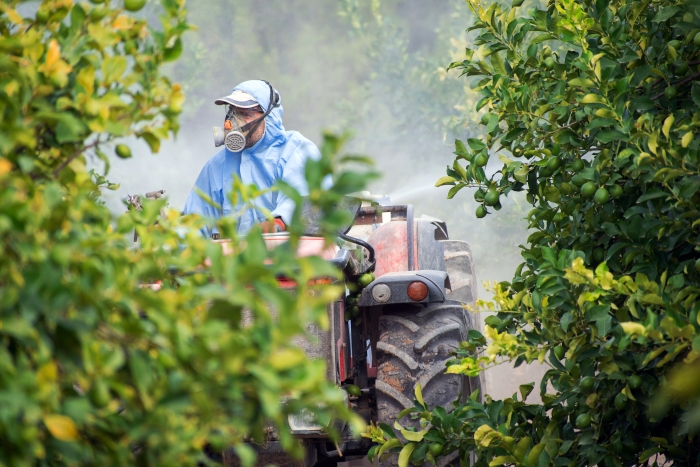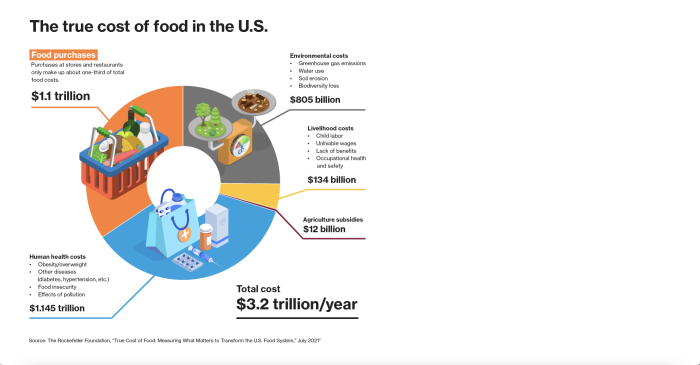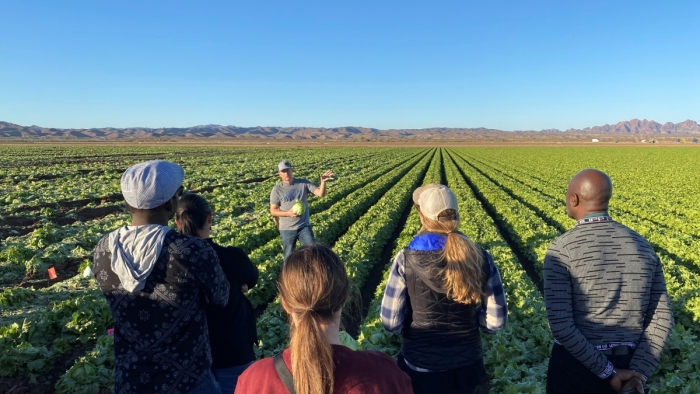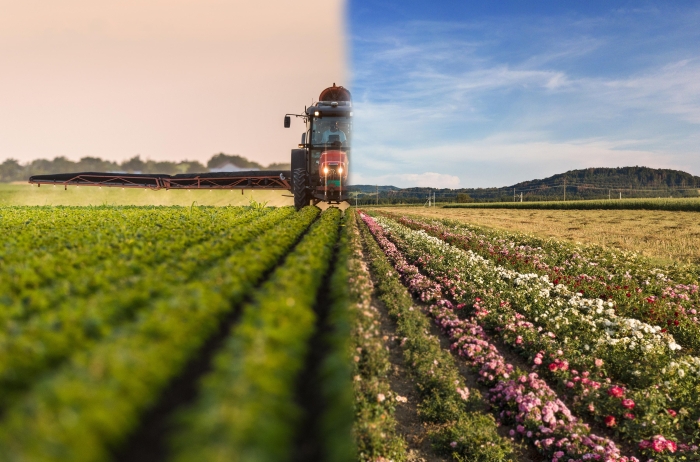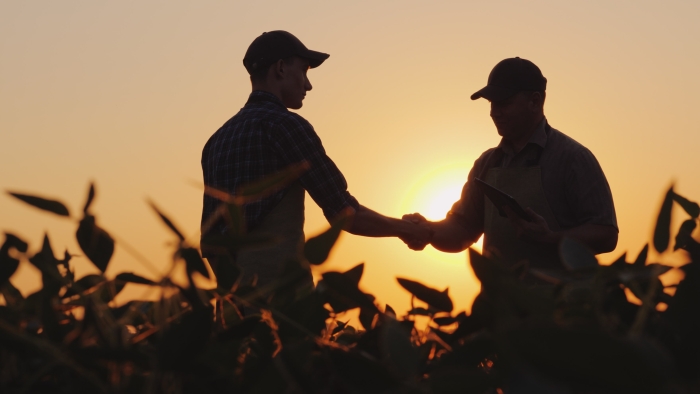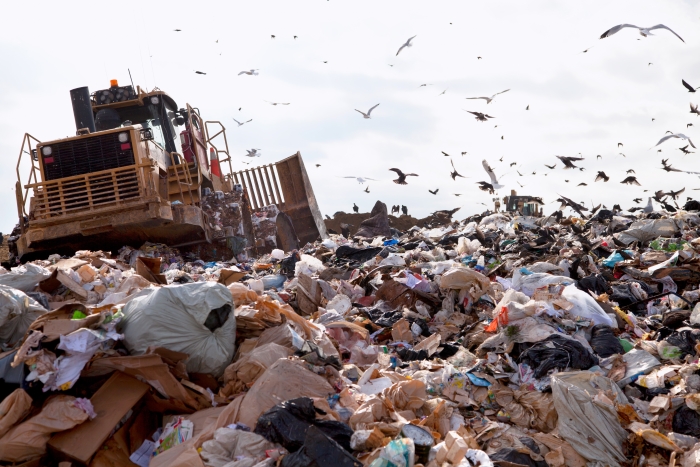The hidden cost of the American food system
ASU experts reveal how food production contributes to climate change; share solutions
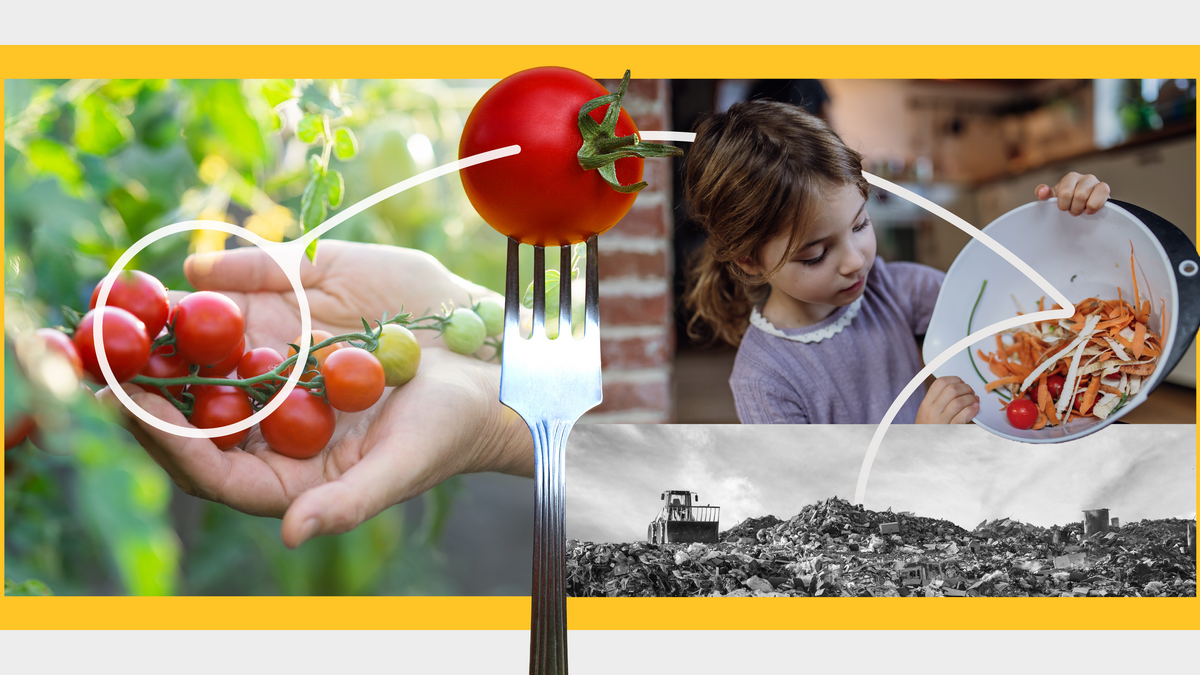
Image by Andy Keena
Editor’s note: This is the third story in a series exploring how ASU tackles complex problems to help transform entire systems for the better. Read the first story, about the role of the university in changing the world, and the second story, about about solving the CO2 problem.
From farm to fork to landfill, the U.S. food system accounts for around 30% of greenhouse gas emissions. Its high environmental price tag, plus the exorbitant toll of processed foods on human health, are hidden costs you’ll never see on your grocery store receipt. Meanwhile, the food system fails to meet the needs of more than 44 million people in the U.S. who face hunger, including 1 in 5 children.
Creating new and sustainable food systems that can support the world’s growing population is going to mean rethinking the fundamentals of farming. Researchers at Arizona State University are working with farmers, government agencies, schools and other partners to transform food systems to promote environmental and individual health, including stamping out hunger.
Sustainable agriculture: Ending chemical warfare on farmland
More than half of the contiguous United States — close to 900 million acres — is devoted to agricultural production, whether fields of crops or pastures for livestock. But the way we grow food or raise livestock on these vast swaths of land is putting increasing pressure on nature. An increased demand for food has polluted much of the nation’s water, soil and air with excess fertilizers and chemical sprays.
Pam Marrone, a senior fellow in ASU’s Swette Center for Sustainable Food Systems, is a successful entrepreneur with more than 400 patents who has founded and led companies focused on biological products for pest management and plant health. She commissioned a study that revealed agriculture’s carbon footprint could be reduced by 90% by replacing synthetic pesticides and fertilizers with products made from natural substances such as plants and microbes.
More articles in this series:
“The study was groundbreaking, but it’s now more widely accepted that biologicals, microorganisms and other natural substances can dramatically change the carbon footprint of farming,” she says.
We can also reduce the need for pesticides by changing some farming practices.
ASU researchers led by Arianne Cease, an associate professor in the School of Sustainability and School of Life Sciences and founding director of the Global Locust Initiative at ASU, have exposed the risks of overgrazing. They made a surprising discovery that links overgrazing land with ravenous locust swarms that regularly sweep across the globe, causing billions of dollars in crop loss. Overgrazing leads to loss of topsoil, loss of organic nitrogen, and plants with a lower nitrogen content and high carbohydrate content, which Cease calls a “doughnut diet” that fuels locusts’ population growth and migratory swarms.
Read more: Overgrazed grasslands tied to locust outbreaks
Cease, also a senior global futures scientist with the Julie Ann Wrigley Global Futures Laboratory, is now working with government agencies worldwide to identify practices that might help stop swarming.
The high cost of cheap food
Beyond the price that consumers pay for food at checkout counters worldwide are $12.7 trillion in hidden costs, reports the United Nations Food and Agriculture Organization. The staggering figure translates to about 10% of global gross domestic product, or $5 per person, per day, worldwide.
Among the hidden costs of food production is farm runoff, a top cause of harmful algae blooms, which release toxins that contaminate drinking water and create dead zones in rivers, lakes and bays. Aquatic life cannot survive in dead zones because of low oxygen levels caused by pollution.
Another hidden cost is food waste, which takes up one-fourth of the space in U.S. landfills, where it rots, generating methane that warms Earth’s climate. Methane is a potent greenhouse gas that has more than 80 times the warming power of carbon dioxide over the first 20 years after it reaches the atmosphere.
Read more: New study finds previously unreported and persistent super-emitting methane plumes from US landfills
The food system also takes a costly toll on human health as people gravitate toward cheap, energy-dense meals when faced with food insecurity, triggering obesity, diabetes and heart disease, among other diet-related conditions.
Exploring these lesser-known costs is the first step toward reducing them, says Alexander Mueller, a Swette Center senior fellow and managing director of TMG, Think Tank for Sustainability.
Mueller is one of the world’s experts on true-cost accounting, which examines the economic, environmental, social and health impacts of food production and consumption to produce a broader picture of its costs and benefits.
“The true costs of food are real, it is not just an academic exercise,” he says. “The full price will be paid in manifold ways — today and tomorrow by our health, by environmental degradation undermining our natural life support systems, or by future generations and people in other continents.”
He adds, “Cheap food in reality is sometimes very expensive.”
Agricultural education: Easing agriculture’s labor shortage
Agriculture and its related industries feed the nation and provide nearly 10% of U.S. employment. But the number of students graduating with degrees in agricultural fields is not meeting industry demand.
Agricultural education needs to attract a diversity of students and keep pace with the increasingly complex nature of agricultural innovation necessary to increase crop yields, boost sustainability and feed a growing world population.
Bolstered by a NextGen grant from the United States Department of Agriculture, ASU is stepping in to fill the critical skills gap. The primary goal of the NextGen program is to create a pipeline of diverse young leaders trained and ready for jobs in the food and agriculture sector, particularly at the USDA.
Increasing diversity in these roles will help ensure that there are many voices in the room to guide food system policymaking, which touches all our lives.
“Our hope is that better-informed students and educated employees will be able to step in to take over some of these positions and manage programs with an eye toward sustainability, equity and keeping the U.S. food system productive and healthy,” says Suzanne Palmieri, director of strategic initiatives at the Swette Center.
The NextGen program includes scholarships for undergraduate and graduate students studying sustainable food systems, paid internship opportunities, workshops to navigate USAjobs.gov, a Model USDA event and more. It engages the community as well, hosting conversations about future USDA workforce needs based on community-identified gaps in service.
Video courtesy ASU Online
“I think it’s already making significant changes in the way we create food solutions, on the ground, in the community, in industry and in the way our students will be trained in innovative ways,” says Melissa K. Nelson (Turtle Mountain Chippewa), a professor of Indigenous sustainability in the School of Sustainability.
Nelson, also a senior global futures scientist with the Global Futures Laboratory, believes bringing an Indigenous perspective to the industrial agricultural system could yield big benefits in sustainability and human health.
“Given the way agriculture is currently being done, there’s a lot of topsoil erosion, waste of water, waste of food and use of pesticides and herbicides,” she says.
While the U.S. industrial food system relies on monocultures, where a single crop is grown, the Indigenous approach uses polycultures of two or more crops grown together. Scientific studies show that growing in polycultures can make crops less susceptible to pests and diseases, while enhancing ecosystems, biodiversity, nutrient cycling, and soil and water conservation.
“Those are examples of how traditional Indigenous agricultural practices have historically been more sustainable and how to work toward that goal,” Nelson adds.
The Farm Bill impacts everyone, not just farmers
Renewed roughly every five years, the Farm Bill is the largest package of legislation in the U.S. dedicated to the country’s food and agriculture systems. In November 2023, Congress voted to extend the 2018 Farm Bill through September of this year. The Congressional Budget Office projects that the United States’ next Farm Bill, a mixture of food assistance and agricultural support, will cost $1.51 trillion, making it the most expensive one in U.S. history.
“The programs that support sustainable agriculture receive pennies on the dollar when compared to what the public is investing in the large-scale industrial system, which is unsustainable,” says Ricardo Salvador, a Swette Center senior fellow and the senior scientist and director of the Food and Environment Program at the Union of Concerned Scientists.
He says row crops lie at the heart of unsustainable agricultural practices in the U.S.
“Imagine 115 million acres of corn and soy as a huge lawn throughout the entire Midwest. Or in the South, it would be soybean, sorghum and cotton. We have these monoculture plantations of just a single crop that lack biodiversity. They require a lot of industrial inputs, mainly fertilizer, very expensive machinery, toxic herbicides and pesticides,” he says.
Row crops are big producers of nitrous oxide, a potent greenhouse gas produced in soils overtreated with nitrogen-based fertilizers. According to one estimate, U.S. croplands emit more than 1 million metric tons of this greenhouse gas each year. Due to the high global warming potential of nitrous oxide, this has the same impact as 300 million metric tons of carbon dioxide.
Though U.S. agriculture takes a heavy toll on the environment, Americans don’t necessarily reap the benefits in our food supply.
“The majority of what U.S. agriculture produces is not food, but actually biofuels such as ethanol and grain that go for livestock feed,” Salvador says. “While the public is told we’re supporting farmers to produce food, we’re importing over 50% of the actual food that we eat. Why should we continue to support that system with very expensive subsidies?”
Ending hunger and food insecurity 1 community at a time
Hunger and food insecurity are widespread in the United States. Approximately 44.2 million people lived in households that had difficulty getting enough food in 2022, up from 33.8 million people the year prior. Those families include more than 13 million children experiencing food insecurity, a jump of nearly 45% from 2021.
One solution is the Slow Food movement, a global, grassroots organization founded in 1989 to prevent the disappearance of local food cultures and traditions, counteract the rise of fast food, and enhance people’s interest in the food they eat, where it comes from and how our food choices affect the world around us.
The Slow Food Phoenix chapter is helping to address food insecurity among Arizona’s children, with 1 out of 4 having inadequate food to eat. Joan McGregor, a senior global futures scientist and philosophy professor in ASU’s School of Historical, Philosophical and Religious Studies, chairs the Slow Food Phoenix board.
Under the Phoenix chapter’s umbrella arose the Blue Watermelon Project, formed to increase access to fresh foods to students in 30 partner schools throughout Phoenix and Tucson. Championed by Charleen Badman, chef and co-owner of FnB restaurant in Scottsdale, Arizona, the program puts chefs in schools, encourages schools to cultivate gardens and teaches children how to make produce taste good.
Video courtesy Blue Watermelon Project
“We’re also doing advocacy work with the legislature, schools and school districts, trying to not only encourage school gardens, but better food in the schools,” McGregor says. “And things are starting to change.”
She cites one success in Arizona as the Arizona Farm to School Network, a statewide hub of connections, research and resources that are gathered and shared to support all communities working to implement and sustain farm to school programming. Getting food directly from local farms to schools introduces children to healthy, fresh food and teaches them where their food comes from. It’s a win-win because selling to schools would boost farmers’ income more than relying upon local farmers markets.
Pitchfork Pantry
ASU’s Pitchfork Pantry is a student-led food pantry that provides fresh produce, rescued groceries and toiletries to ASU community members in need for free.
Malik Yakini is a Swette Center senior fellow and executive director of the Detroit Black Community Sovereignty Network, which operates a 7-acre farm in a city where roughly 69% of households were identified as food insecure in 2021. He is an advocate for urban agriculture and food sovereignty, meaning communities themselves having a say in what their food system will be.
An activist his entire life, over the last 15 years, he has turned his attention toward creating a more equitable food system. He says creating more localized food systems in which food is grown, distributed and sold within communities would be a step in the right direction. Localized food systems could be bolstered by universities, school systems and other public institutions that choose to buy food locally.
Another step is “being very thoughtful about the power of the dollar and how we can use it to support more local, small-scale regenerative farmers instead of supporting the corporate food system that is creating the problems we are faced with,” he says.
Food waste: Becoming a waste watcher
Consumers can improve their health, save money and even protect the environment in a way they might least expect.
“More so than getting an electric car or being thoughtful about turning your lights off in your home, probably the most important thing people can do is reduce food waste,” says Christopher Wharton, senior global futures scientist with the Global Futures Laboratory and associate professor of nutrition in ASU’s College of Health Solutions.
Almost all — 95% — of the food that is thrown away ends up in landfills. The resulting breakdown of wasted food is a large contributor to greenhouse gas emissions, one of the principal drivers of climate change.
“We have found in our research that reducing food waste is really a matter of education,” says Wharton, who piloted a unique educational intervention study to help reduce food waste in 53 Phoenix homes, with successful results.
“We have this magic bucket, the trash can, and when we put things in it, it’s gone from our lives forever and we don’t think about it. But helping people understand what the actual impact of throwing away food is can help them make some changes,” he says.
In the study, participants were not told what researchers were measuring, but they were trained to properly collect, weigh and report the food waste from their households each week. They were also asked to review educational materials such as podcasts, infographics and videos from the Waste Watchers website. The educational resources include three values the researchers theorized would influence better decisions: impacts on health, home finances and the environment.
“People care about food for different reasons. Some people value managing their food and what they eat, some care about how much their food is costing them and some care about environmental impact,” Wharton says.
During the five-week intervention, participants reduced their food waste by nearly 28%.
“Wasting food is a lost opportunity to eat healthily because the largest proportion of food waste in the home is usually fruits, vegetables, whole grains and perishable foods — foods Americans chronically underconsume, resulting in the outcomes that lead to most American deaths — cardiovascular disease and some cancers. If you avoid food waste, you have more opportunities to eat those healthful foods and drive down your risk for deadly diseases,” says Wharton, who also advocates eating a more plant-based diet.
“What’s good for your health is also good for the environment,” he adds.
More Environment and sustainability
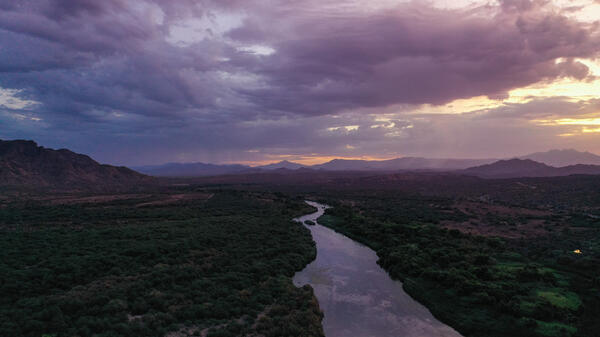
Computer modeling shows where Arizona's winter precipitation originates
The Sun Corridor in Arizona in the semi-arid Southwestern U.S. is a land of seemingly unlimited growth that is constantly colliding with physical constraints. It is mountainous but also home to a…

New free, science-based tool offers insights into sustainability priorities
While more and more businesses are beginning to recognize the benefits of sustainable practices, putting them into action can be confusing and time consuming. The Sustainability Consortium (TSC), a…

ASU-led lab to host community night at Desert Botanical Garden
The Southwest Urban Corridor Integrated Field Laboratory (SW-IFL) will host its very first community night this summer, inviting the public to delve into its groundbreaking research focused on…
